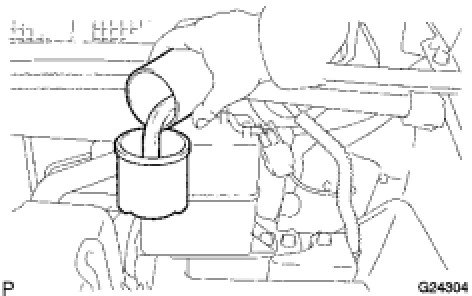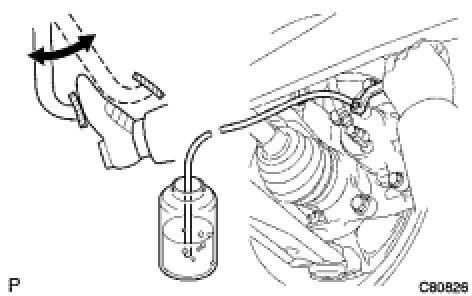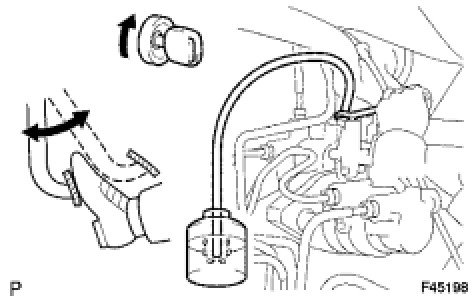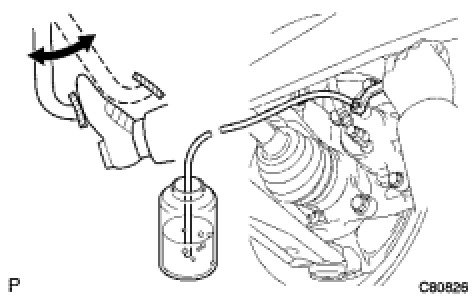Hi and thanks for using 2CarPros. Com.
Here are the bleeding directions specific to your vehicle. They are quite extensive, but I hope you find them helpful.
__________________________________________________
2010 Toyota Truck Sienna FWD V6-3.5L (2GR-FE)
Vehicle  Brakes and Traction Control  Brake Bleeding  Service and Repair
SERVICE AND REPAIR
BRAKE: BRAKE FLUID: BLEEDING
HINT
If any work is performed on the brake system or if air in the brake lines is suspected, bleed the air out of the brake system.
NOTICE:
Wash the brake fluid off immediately if it adheres to any painted surfaces.
REMOVE COWL TOP PANEL SUB-ASSEMBLY OUTER FRONT See: Steering and SuspensionSuspensionSuspension Strut / Shock AbsorberService and RepairRemoval and ReplacementFront Shock AbsorberRemoval
FILL RESERVOIR WITH BRAKE FLUID
Fluid:
SAE J1703 or FMVSS No. 116 DOT3
NOTICE:
Perform the procedure after confirming the sub-tank at the upper of the master cylinder assembly is filled enough.
BLEED BRAKE LINE
(a) Connect the vinyl tube to the bleeder plug.
(b) Depress the brake pedal several times, then loosen the bleeder plug with the pedal depressed (*1).
(c) At the point when fluid stops coming out, tighten the bleeder plug, then release the brake pedal (*2).
(d) Repeat (*1) and (*2) several times until all the air in the fluid is completely bled out.
(e) Tighten the bleeder plug completely.
Disc - Torque : 8.3 Nm (85 kgf-cm, 73 in-lbf)
Drum - Torque : 11 Nm (112 kgf-cm, 8 ft-lbf)
(f) Repeat the above procedure to bleed the air out of the brake line for each wheel.
BLEED MASTER CYLINDER
NOTICE:
When the air is bled from the master cylinder (3rd chamber), be sure to run the engine.
HINT
If the master cylinder has been disassembled or if the reservoir becomes empty, bleed the air out of the master cylinder.
(a) Run the engine at idle.
(b) Connect the vinyl tube to the brake caliper bleeder plug.
(c) Open the brake caliper bleeder plug or wheel cylinder bleeder plug.
(d) Depress the brake pedal several times, then loosen the master cylinder (3rd chamber) bleeder plug with the pedal held down (*3).
(e) At the point when the fluid stops coming out, tighten the master cylinder (3rd chamber) bleeder plug, then release the brake pedal (*4).
(f) Repeat (*3) and (*4) several times until the air in the master cylinder is bled out.
(g) Tighten the master cylinder (3rd chamber) bleeder plug.
Torque : 11 Nm (112 kgf-cm, 8 ft-lbf)
(h) Tighten the brake caliper bleeder plug or wheel cylinder bleeder plug.
Disc - Torque : 8.3 Nm (85 kgf-cm, 73 in-lbf)
Drum - Torque : 11 Nm (112 kgf-cm, 8 ft-lbf)
BLEED BRAKE LINE
(a) Connect the vinyl tube to the bleeder plug.
(b) Depress the brake pedal several times, then loosen the bleeder plug with the pedal depressed (*5).
(c) At the point when fluid stops coming out, tighten the bleeder plug, then release the brake pedal (*6).
(d) Repeat (*5) and (*6) several times until all the air in the fluid is completely bled out.
(e) Tighten the bleeder plug completely.
Disc - Torque : 8.3 Nm (85 kgf-cm, 73 in-lbf)
Drum - Torque : 11 Nm (112 kgf-cm, 8 ft-lbf)
(f) Repeat the above procedure to bleed the air out of the brake line for each wheel.
BLEED BRAKE ACTUATOR (w/ VSC)
NOTICE:
After bleeding the air from the brake system, if the height or feel of the brake pedal cannot be obtained, bleed the air from the brake actuator assembly with the Techstream by following the procedure below.
(a) Depress the brake pedal more than 20 times with the ignition switch off.
(b) Connect the Techstream to the DLC3, then turn the ignition switch to the ON position.
NOTICE:
Do not start the engine.
(c) Turn the Techstream on and select "AIR BLEEDING" on the screen.
NOTICE:
* Refer to the Techstream operator's manual for farther details.
* Perform air bleeding by following the steps displayed on the Techstream.
(d) Perform air bleeding according to "Step 1: Increase" on the Techstream display.
NOTICE:
Make sure that the master cylinder reservoir tank does not become empty of brake fluid.
(1) Connect a vinyl tube to either one of the bleeder plugs.
(2) Depress the brake pedal several times, then loosen the bleeder plug connected to the vinyl tube with the pedal depressed (*7).
(3) When fluid stops coming out, tighten the bleeder plug, then release the brake pedal (*8).
(4) Repeat (*7) and (*8) until all the air in the fluid is completely bled out.
(5) Tighten the bleeder plug completely.
Disc - Torque : 8.3 Nm (85 kgf-cm, 73 in-lbf)
Drum - Torque : 11 Nm (112 kgf-cm, 8 ft-lbf)
(6) Repeat the above procedures for the rest of the wheels to bleed the air from the brake
line.
(e) Bleed the air from the suction line according to "Step 2: Inhalation" on the Techstream display.
NOTICE:
* Bleed the suction line by following the steps displayed on the Techstream.
* Make sure that the master cylinder reservoir tank does not become empty of brake fluid.
(1) Connect a vinyl tube to the bleeder plug at the right front wheel or the right rear wheel and loosen the bleeder plug.
(2) Operate the brake actuator assembly to perform air bleeding using the Techstream (*9).
NOTICE:
* The operation stops automatically in 4 seconds.
* At this time, be sure to release the brake pedal.
(3) Check that the operation has stopped by referring to the Techstream display and tighten the bleeder plug (*10).
(4) Repeat (*9) and (*10) until all the air in the fluid is completely bled out.
(5) Tighten the bleeder plug completely.
Disc - Torque : 8.3 Nm (85 kgf-cm, 73 in-lbf)
Drum - Torque : 11 Nm (112 kgf-cm, 8 ft-lbf)
(6) For the rest of the wheels, perform air bleeding in the same way as stated in the above procedure.
(f) Bleed the air from the pressure reduction line according to "Step 3: Decrease" on the Techstream display.
NOTICE:
* Bleed the pressure reduction line by following the steps displayed on the Techstream.
* Make sure that the master cylinder reservoir tank does not become empty of brake fluid.
(1) Connect a vinyl tube to either one of the bleeder plugs.
(2) Loosen the bleeder plug (*11).
(3) Using the Techstream, operate the brake actuator assembly, completely depress the brake pedal, and hold it.
NOTICE:
* The operation stops automatically in 4 seconds. When performing this procedure continuously, an interval of at least 20 seconds is required.
* When the operation is completed, the brake pedal goes down slightly. This is a normal phenomenon when the solenoid opens.
* During this procedure, the pedal seems heavy, but completely depress it so that the brake fluid comes out from the bleeder plug.
* Be sure to keep the brake pedal depressed. Never depress and release the pedal repeatedly.
(4) Tighten the bleeder plug, then release the brake pedal (*12).
(5) Repeat (*11) to (*12) until all the air in the fluid is completely bled out.
(6) Tighten the bleeder plug completely.
Disc - Torque : 8.3 Nm (85 kgf-cm, 73 in-lbf)
Drum - Torque : 11 Nm (112 kgf-cm, 8 ft-lbf)
(7) Repeat the above procedures for the rest of the brakes to bleed the air from the brake line.
(g) Bleed the air from the brake line again according to "Step 4: Increase" on the Techstream display.
NOTICE:
* Bleed the brake line by following the steps displayed on the Techstream.
* Make sure that the master cylinder reservoir tank does not become empty of brake fluid.
(1) Connect a vinyl tube to either one of the bleeder plugs.
(2) Depress the brake pedal several times, then loosen the bleeder plug connected to the vinyl tube with the pedal depressed (*13).
(3) When fluid stops coming out, tighten the bleeder plug, then release the brake pedal (*14).
(4) Repeat (*13) and (*14) until all the air in the fluid is completely bled out.
(5) Tighten the bleeder plug completely.
Disc - Torque : 8.3 Nm (85 kgf-cm, 73 in-lbf)
Drum - Torque : 11 Nm (112 kgf-cm, 8 ft-lbf)
(6) Repeat the above procedures for each brake to bleed the air from the brake line.
(h) Finish "AIR BLEEDING" on the Techstream and turn off the Techstream.
(i) Disconnect the Techstream from the DLC3.
(j) Turn the ignition switch to the OFF position.
CHECK FLUID LEVEL IN RESERVOIR
(a) Check the fluid level and add fluid, if necessary.
Fluid:
SAE J1703 or FMVSS No. 116 DOT3
INSTALL COWL TOP PANEL SUB-ASSEMBLY OUTER FRONT See: Steering and SuspensionSuspensionSuspension Strut / Shock AbsorberService and RepairRemoval and ReplacementFront Shock AbsorberInstallation
______________________________________________________
I hope this is helpful. Let me know if you have other questions.
Take care,
Joe
Images (Click to make bigger)
Saturday, June 9th, 2018 AT 9:31 PM







